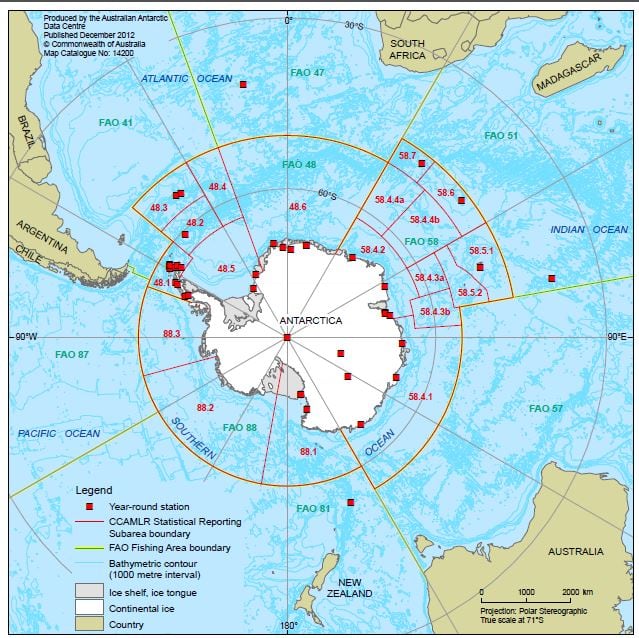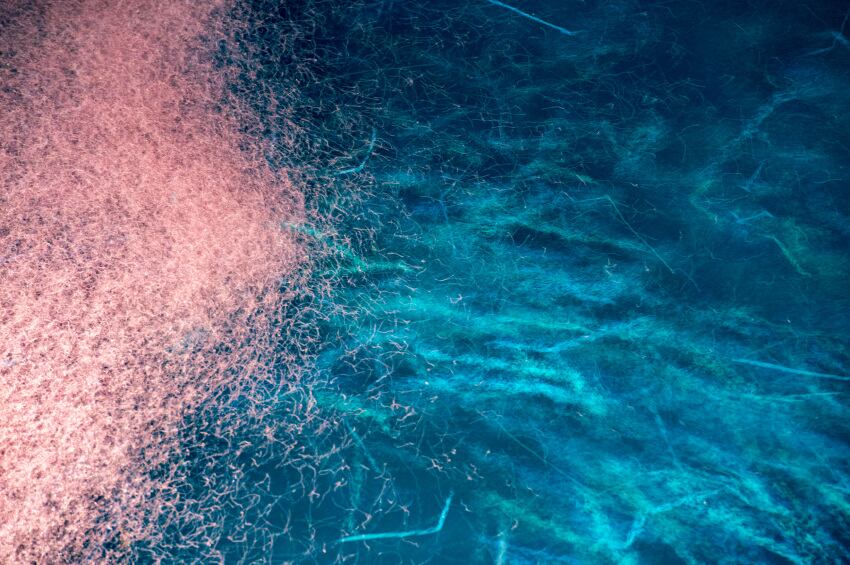In 2015, 225,646 tonnes of the krill species Euphausia superba were caught in one region of the Antarctic alone, called area 48.
But it wasn’t always so concentrated, and registrations for fishing next year suggest it might not stay this way for long.
For Dr Keith Reid, Conservation of Antarctic Marine Living Resources (CCAMLR) science manager and honorary research associate at the University of Tasmania, to understand the krill fishing industry you have the look at the boom and bust of the Soviet Union.
Fishing for socialism
At the very beginning of the industry in the early 1970s, humble annual catches of krill were fairly evenly spread between areas 48 and 58.
In those days, Russia ruled the waves and catch peaked in 1982 when 373,656 tonnes of krill were caught in area 48 and 148,038 tonnes in area 58.
Since the ‘company’ behind Russian vessels was the state, the ships worked co-operatively not competitively by alerting other compatriot ships when they found a patch of krill. Reid said this meant there was less pressure to fish in areas with predictable krill patterns.
Records show krill catch began dropping off in the USSR’s rocky years, and in 1993 – just after the official dissolution of the Union on 26 December 1991 – the catch was just 60,783 tonnes in area 48 and 5,762 tonnes in area 58.

Today there are no Russian ships fishing krill in the Antarctic, with catch coming instead from Norwegian, Korean and Chinese vessels.
“Prior to the Soviet Union fall, [Russia] had hundreds of ships,” executive vice president of production and supply chain at Norwegian krill player Aker BioMarine, Webjørn Eikrem, told us.
“Without government funding they just faded out.”
For Reid this had a big impact on krill fishing habits.
“The fall of the Soviet Union changed the dynamic of fishing,” he said.
Competition between privately owned ships means a greater focus on sector 48 and a shift away from the shelf area of sector 58, where stock is deeper and big concentrations more difficult to find.
A tide change?
CCAMLR was set up in 1982 in response to increasing commercial interest in the krill resources of the Antarctic ocean, which is sometimes referred to as the ‘world’s last frontier’ because of its pristine waters and the more than 9,000 species it alone plays home to.
Part of CCAMLR's remit is the formation of marine protected areas (MPAs), where fishing may be limited or banned altogether.
Most recently the Ross Sea or ‘domain 8’, an area the size of the UK and France combined, was named a 'no-take' zone.
Other areas are also on the agenda, including the krill fishing spot, area 48.
An as yet undecided proposal is expected in the next two or three years, but Reid said it was unlikely this would mean a blanket ban on commercial activity and fishing but more like a “mosaic” of allowances, limits and outright prohibitions.
Krill is a key part of the marine food chain and is the largest under-exploited marine resource on the planet, presenting both significant management challenges and opportunities.
CCAMLR sets a catch limit of 620,000 tonnes distributed across four regions in the southwest Atlantic. This 'trigger' level represents about 1% of the estimated 60m tonnes of the unexploited biomass of the krill population in this region, a level CCAMLR has agreed should not be expanded unless scientific data indicates this would continue to be sustainable. The actual annual catch sits far below this at around 0.3%.
Aker BioMarine’s Eikrem warned of a squeeze and shift effect.
“When you close down one area, one thing is you protect that area, but the other thing is you increase the concentration in another,” said Eikrem, who is also president of the Association of Responsible Krill Harvesters (ARK).
“It’s a double-edged sword sometimes.”
China eyes area 58
Indeed according to the Commission for the CCAMLR register of vessels, this year Chinese firm the Qingdao Deep-Sea Fishing Company registered its vessel to fish in area 58 making it the only company seeking the right to krill fish in the area since the 90s.
The divisions 58.4.1 and 58.4.2 have fairly sizable krill catch allowances at 440,000 and 2,645,000 tonnes, respectively, but for years the remote areas have been used for research purposes only.
“It’s not the first time [a company has registered for 58], but it’s the first time it’s been done with some forethought. It’s not just ticking boxes,” said Reid.
The Chinese company did not respond to our requests for comment, but Reid said a renewed interest in sector 58 was likely based on long-term business strategies.
“Clearly if you’re looking long-term and the expansion is limited in some areas, you will want to know what options there are.”
Earlier this year our sister publication NutraIngredients-Asia reported that the Chinese government was upping its support of the krill industry and state-owned China National Agricultural Development Group told the newspaper China Daily that it intended to increase its annual capacity by up to 60 times over the next few years.

‘You have to have deep pockets’
Expansion may be what’s needed in the krill omega-3 market, which its own players concede is a tough market to make profit on.
“You have to have deep pockets, in the first year at least,” said Aker Biomarine’s Eikrem.
“I don’t believe the industry has made a lot of money in the last 10 years.”
Yet he said the company remained hopeful for the future of the krill ingredients industry.
“We’re not losing any money anymore. For the last couple of years at least we’ve been breaking even.”
He said it was difficult to make predictions about the future of the market or the fishing restrictions it may face, but he hoped decisions would be based on solid data and the company was working with the Norwegian Research Institute in Bergen to ensure this.
